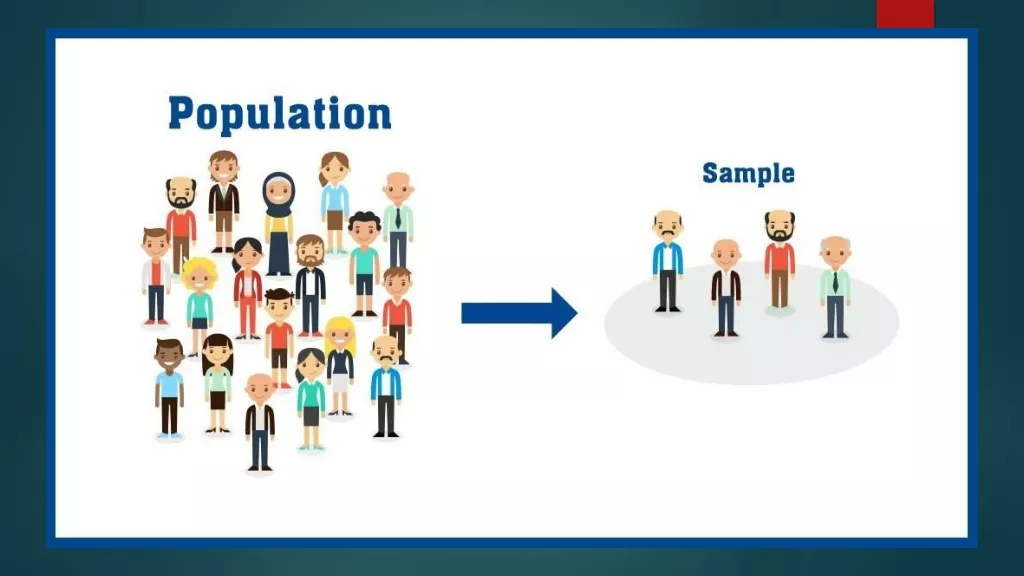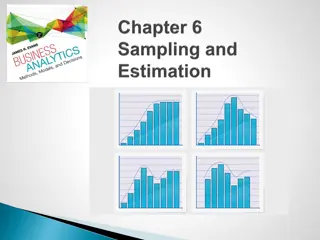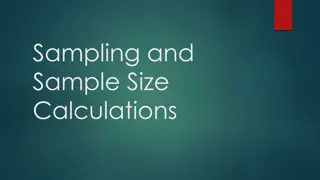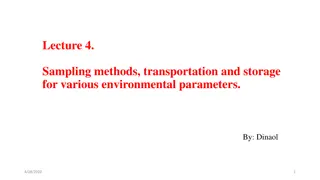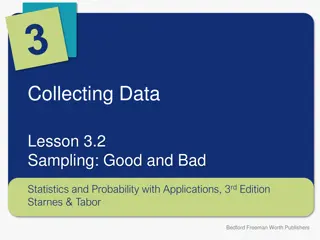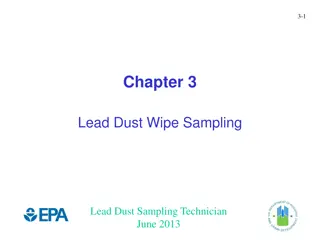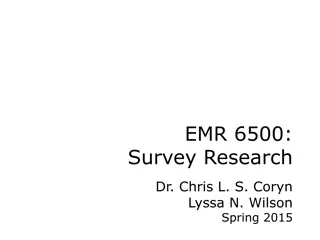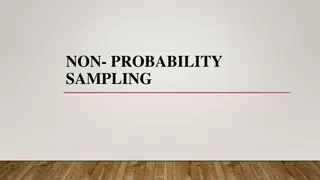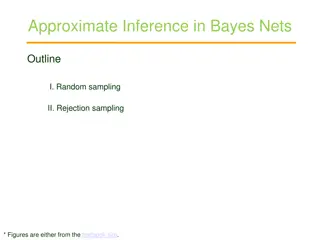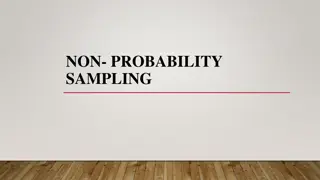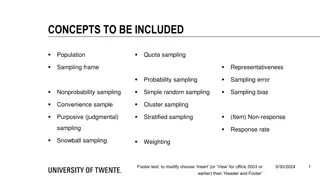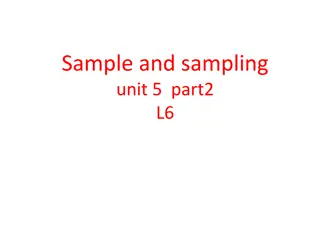Survey Research and Sampling: Basic Concepts and Procedures
In this content, you will explore essential concepts and procedures related to survey research and sampling. Topics covered include elements of the sampling problem, technical terms, and how to select a sample to estimate population parameters. The material delves into the importance of sampling procedures, determining the number of sampling units, and setting a bound on the error of estimation in order to ensure accurate results.
Uploaded on Mar 16, 2025 | 2 Views
Download Presentation

Please find below an Image/Link to download the presentation.
The content on the website is provided AS IS for your information and personal use only. It may not be sold, licensed, or shared on other websites without obtaining consent from the author.If you encounter any issues during the download, it is possible that the publisher has removed the file from their server.
You are allowed to download the files provided on this website for personal or commercial use, subject to the condition that they are used lawfully. All files are the property of their respective owners.
The content on the website is provided AS IS for your information and personal use only. It may not be sold, licensed, or shared on other websites without obtaining consent from the author.
E N D
Presentation Transcript
ENGINEERING MANAGEMENT (GE 404) 1 LECTURE # LECTURE #4 4 Scheduling Networks- AON March 16, 2025 GE 404 (Engineering Management)
Contents 2 Objectives of the present lecture Activities versus events Duration versus Event Constraints Network Modeling Technique Steps in building a network model Early Start, Early Finish and Early Finish and Early Start Times Float Times Developing AON Network Problems Further reading March 16, 2025 GE 404 (Engineering Management)
Objectives of the Present lecture 3 To provide an overview of CPM based Network Modeling Techniques To discuss steps involved in drawing AON network diagrams To discuss how to calculate Early/Late Start/Finish Times To learn how to identify critical path in AON network diagrams March 16, 2025 GE 404 (Engineering Management)
Activities versus Events 4 Events Activities Events simply occur at a point in time The point in time at which an activity can start may be considered an event The point in time or instant at which an activity is completed can also be considered an event Activities consume time. March 16, 2025 GE 404 (Engineering Management)
Duration versus Event 5 Event Duration The duration of an activity is the period of time that will be consumed completing a task The duration of the activity includes the time at which the activity begins and continues to the point in time at which completed. An event is the point in time or an instant at which the status of completion of a project or activity can be defined. The starting time for an activity, which is also an event, defines that point in time at which an activity can begin. in it is March 16, 2025 GE 404 (Engineering Management)
Constraints 6 A number of different constraints must be acknowledged by the project team. The common constraints are: Physical Constraints Resource Constraints Productivity Constraints Safety Constraints Financial Constraints Environmental Constraints Management Constraints Contractual Constraints Regulatory Constraints March 16, 2025 GE 404 (Engineering Management)
Impact of Constraints 7 Introduction of excessive constraints in network logic can have the following impacts on a project: Reduce scheduling flexibility Lengthen project duration Generally increase project cost Confuse basic scheduling logic March 16, 2025 GE 404 (Engineering Management)
Network Modeling TechniqueCPM 8 CPM is the most popular network modeling technique In CPM technique, each activity is assigned a specific duration and calculations through the network provide a single, specific duration for the project as a whole CPM identifies those chains of activities (the critical paths) in the project that control how long the project will take There are two popular variations of CPM Activity-on-Arrow (A-on-A), or an arrow diagram This name is given to this traditional technique because activities are represented in the network as arrows or lines Activity-on-Node or Precedence technique This method defines the activities as boxes (nodes in the network), which are connected together by lines (links). This technique has got popularity because of the availability of microcomputer software, which makes it very easy to use. March 16, 2025 GE 404 (Engineering Management)
Steps in Building a Network Model 9 Define activities Order activities Establish activity relationships; draw a network diagram Determine quantities; assign durations to activities Assign resources and costs Calculate early and late start/finish times Compute float values and identify the critical path Schedule activity start/finish times March 16, 2025 GE 404 (Engineering Management)
Defining Activities 10 Production/Construction Activities These are activities that relate directly to the physical effort of creating the project These activities use traditional resources of labor and materials Procurement Activities These activities include arranging for the acquisition of materials, money, equipment, and workforce Management Activities Activities such as preparing inspection reports, processing shop drawing approvals, tracking submittal approvals, developing as-built drawings, providing certifications on factory tests performed, and a variety of similar tasks. March 16, 2025 GE 404 (Engineering Management)
Ordering Activities 11 For each identified activity, the following must be determined: Which activities must precede it? Which activities must follow it? Which activities can be concurrent with it? March 16, 2025 GE 404 (Engineering Management)
Assigning Durations to Activities 12 The duration of an activity is the estimated time that will be required to complete it Duration of the activity can be computed as: Qunatity of work = = crew hours Duration (days) ( ) qty/crew hour Number of crews An alternative is to use historical Quantitative data from actual projects the firm has previously undertaken March 16, 2025 GE 404 (Engineering Management)
Early Start, Early Finish and Late Finish and Late Start Times 13 The "Early Start" (ES) or "Earliest Start" of an activity is the earliest time that the activity can possibly start allowing for the time required to complete the preceding activities. The "Early Finish" (EF) or "Earliest Finish" of an activity is the earliest possible time that it can be completed and is determined by adding that activity's duration to its early start time. The Late Finish" (LF) or "Latest Finish" of an activity is the very latest that it can finish and allow the entire project to be completed by a designated time or date. The Late Start (LS) or "Latest Start" of an activity is the latest possible time that it can be started if the project target completion date is to be met and is obtained by subtracting the activity's duration from its latest finish time. March 16, 2025 GE 404 (Engineering Management)
Calculation of Early and Late times 14 Late Early Direction: Proceed from project end to project start, Direction: Proceed from project start to project finish, from left to right. from right to left. Name: This process is called the backward pass". Name: This process is called the "forward pass". Assumption: Each activity finishes as late as Assumption: every activity will start as early as possible. That is to say, each activity will start just as soon as the last of its predecessors is finished. possible without delaying project completion. The LF value of each activity is obtained first and is The ES value of each activity is determined first. entered into lower right portion of the activity box. The EF time is obtained by adding the activity duration to the ES time. EF = ES + D The LS is obtained by subtracting the activity duration from the LF value. LS = LF - D In case of merge activities the earliest possible start time is equal to the latest (or largest) of the EF values of the immediately preceding activities. In case of burst activities LF value is equal to the earliest (or smallest) of the LS times of the activities following. March 16, 2025 GE 404 (Engineering Management)
Float Times Free and Total Floats 15 Float (or leeway) is a measure of the time available for a given activity above and beyond its estimated duration. The free float of an activity is found by subtracting its earliest finish time from the earliest start time of the activities directly following: FFi = Min. (ESj) - EFi The Total float of an activity is obtained by subtracting its ES time from its LS time. Subtracting the EF from the LF gives the same result. Total float (TF) = LS - ES = LF - EF An activity with zero total float has no spare time and is, therefore, one of the operations that controls project completion time. Activities with zero total float are called critical activities. March 16, 2025 GE 404 (Engineering Management)
Free and Total Floats 16 Total Float or Path Float Free Float or activity Float Free float is the amount of time that an activity s completion time may be delayed affecting the earliest start of succeeding activity Total float is the amount of time that an activity s completion may be delayed without affecting the earliest start of any activity on the network critical path Total float is shared by all activities along a slack path Total path float time for activity (i-j) is the total float associated with a path without Free float is owned by an individual activity March 16, 2025 GE 404 (Engineering Management)
Activity Box 17 Duration Earliest Finishing Date Earliest Starting Date ES D EF Free Float Activity ID TF FF Predecessor Successor LS LF Latest Finishing Date Latest Starting Date Total Float The format for activity box is not standardized, so one need only to adopt a format that is comfortable for a particular application March 16, 2025 GE 404 (Engineering Management)
Critical Activity and Critical Path 18 Critical activity is quickly identified as one whose two start times at the left of the activity box are equal. Also, equal are the two finish times at the right of the activity box. The critical activities must form a continuous path from project beginning to project end, this chain of critical activities is called the Critical Path. The critical path is the longest path in the network. The critical path is normally indicated on the diagram in some distinctive way such as with colors, heavy lines, or double lines. Any delay in the finish date of a critical activity, for whatever reason, automatically prolongs project completion by the same amount. March 16, 2025 GE 404 (Engineering Management)
Subcritical paths 19 Subcritical paths have varying degree of path float and hence depart from criticality by varying amounts Subcritical paths can be found in the following way: Sort the activities in the network by their path float, placing those activities with a common path float in the same group Order the activities within a group by early start time Order the groups according to the magnitude of their path float, small values first March 16, 2025 GE 404 (Engineering Management)
Activity-on-Node (AON) Network 20 The most common type of network schedule in use today is the Activity-on-Node Activities are represented by nodes, drawn in any desired shape Lines represent Activity links, used to represent dependencies between activities The principal advantage of the activity on node network is that it eliminates the need for dummies The diagram is read from left to right March 16, 2025 GE 404 (Engineering Management)
Developing AON Network 21 The general developing of a network is from start to finish, from project beginning on the left to project completion on the right. A horizontal diagram format is the standard format The sequential relationship of one activity to another is shown by the dependency lines between them. The length of the lines between activities has no significance. Arrowheads are not always shown on the dependency lines because of the obvious left to right flow of time. Dependency lines that go backward from one activity to another (looping) should not be used. Crossovers occur when one dependency line must cross over another to satisfy job logic. March 16, 2025 GE 404 (Engineering Management)
Note 22 Each activity in the network must be preceded either by the start of the project or by the completion of a previous activity. Each path through the network must be continuous with no gaps, discontinuities, or dangling activities. All activities must have at least one activity following, except the activity that terminates the project. Each activity should have a unique numerical designation (activity code). Activity code is shown in the central part of the activity box, with the numbering proceeding generally from project start to finish. March 16, 2025 GE 404 (Engineering Management)
Problem-1 23 The activity list shown below represents the activities, the job logic and the activities durations of a small project. Draw an activity on node network to represent the project. Activity A B C E F D S R Depends on D R D R, S B, C None A, C A, C Duration (days) 4 5 8 7 3 4 2 9 ES t EF Activity LS TF LF March 16, 2025 GE 404 (Engineering Management)
Solution ES t EF Activity Step-1: Draw Activity diagram LS TF LF 24 4 2 When you have to draw an activity diagram. Pick the first activity and then see on which it depends and then see on which these (i.e. predecessors) depend. For example, to draw activity A, see activity D then see on which activity D depends and so on. S A 4 7 0 D E END 8 9 3 5 C B R F March 16, 2025 GE 404 (Engineering Management)
Step-2: Calculate ES and EF and Project duration EF = ES + D 25 In forward pass you may encounter merge activities (e.g. S and R are merging to E) whereas in backward pass you can encounter burst activities (e.g. A and C are bursting from D) 4 12 14 4 2 8 S A Largest EF 4 4 29 7 0 21 28 29 D E END 4 12 12 21 21 26 26 29 8 9 3 5 C B R F March 16, 2025 GE 404 (Engineering Management)
Step-3: Calculate LS and LF 26 LS = LF - D 4 2 4 12 14 8 S A 8 12 20 22 4 0 4 29 7 0 21 28 29 D E END 0 4 22 29 29 29 4 12 12 21 21 26 26 29 8 9 3 5 C B R F 12 4 12 21 21 26 26 29 Smallest LS March 16, 2025 GE 404 (Engineering Management)
Step-4: Calculate Total Float 27 Total float (TF) = LS - ES = LF - EF 4 2 4 12 14 8 S A 8 4 12 20 8 22 4 0 4 29 7 0 21 28 29 D E 1 END 0 0 0 4 22 29 29 29 4 12 12 21 21 26 26 29 8 9 3 5 C 0 B 0 R 0 F 0 12 4 12 21 21 26 26 29 March 16, 2025 GE 404 (Engineering Management)
Step-5: Identify Critical Path 28 4 2 4 12 14 8 S A 8 4 12 20 8 22 4 0 4 28 29 7 0 21 29 D E 1 END 0 0 0 4 22 29 29 29 4 12 12 21 21 26 26 29 8 9 3 5 C 0 B 0 R 0 F 0 12 4 12 21 21 26 26 29 March 16, 2025 GE 404 (Engineering Management)
Problem-2 29 Draw AON diagram to represent the following project. Calculate occurrence times of events (i.e. activity times), and activity and path floats. Also determine the critical path and the degree of criticality of other float paths. Activity A B C D E F G H I Preceding Activity None A A A B D E, C, F G G Time (days) 5 7 4 8 6 8 3 4 6 ES t EF Activity LS TF LF March 16, 2025 GE 404 (Engineering Management)
Solution Step 1: Activity on node network 30 5 7 12 B 12 6 18 E 24 4 28 H 8 3 15 15 3 21 26 2 30 0 5 A 5 5 4 C 9 21 3 24 G 30 0 30 END 0 0 5 17 12 21 21 0 24 30 0 30 24 6 30 I 5 8 13 D 13 8 21 F 24 0 30 5 0 13 13 0 21 March 16, 2025 GE 404 (Engineering Management)
Step 2: Activity times and activity floats 31 Activity A B C D E F G H I ES 0 5 5 5 12 13 21 24 24 EF 5 12 9 13 18 21 24 28 30 LF 5 15 21 13 21 21 24 30 30 LS 0 8 17 5 15 13 21 26 24 TF 0 3 12 0 3 0 0 2 0 FF 0 0 12 0 3 0 0 2 0 March 16, 2025 GE 404 (Engineering Management)
Step 3: Critical path and subcritical paths 32 Activity A D F G I H B E C ES 0 5 13 21 24 24 5 12 5 EF 5 13 21 24 30 28 12 18 9 LF 5 13 21 24 30 30 15 21 21 LS 0 5 13 21 24 26 8 15 17 TF 0 0 0 0 0 2 3 3 12 Criticality Critical Path a near critical path Third most critical path Path having most float March 16, 2025 GE 404 (Engineering Management)
Problem-3 33 The activity list shown below represents the activities, the job logic and the activities durations of a small project. Draw an activity on node network to represent the project. Activit y A B C D E F G H Immediate Predecessors A A, B C C D, E F, G Time (weeks) 2 3 2 4 4 3 5 2 Description Build internal components Modify roof and floor Construct collection stack Pour concrete and install frame Build high-temperature burner Install pollution control system Install air pollution device Inspect and test ES t EF Activity LS TF LF March 16, 2025 GE 404 (Engineering Management)
Solution Step-1: Draw Activity diagram 34 2 2 3 C A F 2 0 4 H Start E 4 5 3 B G D March 16, 2025 GE 404 (Engineering Management)
Step-2: Calculate ES and EF and Project duration 35 0 2 2 4 4 2 2 7 3 A C F ES 13 15 2 0 0 4 8 0 4 H Start E MAX(EF of Preceding activities 7,8) 3 7 4 0 3 8 13 5 3 B G D March 16, 2025 GE 404 (Engineering Management)
Step-3: Calculate LS and LF 36 LS = LF - D 0 2 2 4 4 2 2 7 3 C A F 2 0 2 4 10 13 13 15 2 0 0 4 8 0 4 H LF = Min(LS of activities 4,10) Start E 15 13 0 0 4 8 LF = EF of Project 3 7 4 0 3 8 13 5 3 B G D 1 4 8 8 13 4 March 16, 2025 GE 404 (Engineering Management)
Step-4: Calculate Total Float 37 Total float (TF) = LS - ES = LF - EF Slack = LS ES or Slack = LF EF 0 2 2 4 4 2 2 7 3 C 0 A 0 F 6 0 2 2 4 10 13 13 15 2 0 0 4 8 0 4 H 0 Start 0 E 15 13 0 0 4 8 0 LF = EF of Project 3 7 4 0 3 8 13 5 3 B 1 G 0 D 1 1 4 8 8 13 4 March 16, 2025 GE 404 (Engineering Management)
Step-5: Identify Critical Path 38 0 2 2 4 4 2 2 7 3 C 0 A 0 F 6 0 2 2 4 10 13 13 15 2 0 0 4 8 0 4 H 0 Start 0 E 15 13 0 0 4 8 0 3 7 4 0 3 8 13 5 3 B 1 G 0 D 1 1 4 8 8 13 4 March 16, 2025 GE 404 (Engineering Management)
Step-6: Calculate Slack Time (Float Time) 39 Earliest Earliest Latest Start Finish Activity ES A 0 B 0 C 2 D 3 E 4 F 4 G 8 H 13 Latest Finish LF 2 4 4 8 8 13 13 15 On Start LS 0 1 2 4 4 10 8 13 Slack LS ES 0 1 0 1 0 6 0 0 Critical Path Yes No Yes No Yes No Yes Yes EF 2 3 4 7 8 7 13 15 March 16, 2025 GE 404 (Engineering Management)
GANTT CHART SCHEDULE (ES EF ) ACTIVITY 1 2 3 4 5 6 7 8 9 10 11 12 13 14 15 16 A Build internal components C Construct collection stack Build high-temperature burner E Install air pollution device G H Inspect and test B Modify roof and floor D Pour concrete and install frame F Install pollution control system GANTT CHART SCHEDULE (LS LF ) ACTIVITY 1 2 3 4 5 6 7 8 9 10 11 12 13 14 15 16 A Build internal components C Construct collection stack Build high-temperature burner E Install air pollution device G H Inspect and test B Modify roof and floor D Pour concrete and install frame F Install pollution control system 40 March 16, 2025 GE 404 (Engineering Management)
Calendar Date Schedule 41 Activity times (ES, EF, LS, LF) obtained from previous calculations are expressed in terms of expired working days. For purposes of project directing, monitoring and control, it is necessary to convert these times to calendar dates on which each activity is expected to start and finish. This is done with the aid of a calendar on which the working days are numbered consecutively, starting with number 1 on the anticipated start date and skipping weekends and holidays. March 16, 2025 GE 404 (Engineering Management)
Advantages and Disadvantages of Network Diagram 42 Advantages Show precedence well Reveal interdependencies not shown in other techniques Ability to calculate critical path Ability to perform whatif exercises Disadvantages Default model assumes resources are unlimited You need to incorporate this yourself (Resource Dependencies) when determining the real Critical Path Difficult to follow on large projects March 16, 2025 GE 404 (Engineering Management)
Note (a Constraint) 43 Question: The last activity in a chain has no successor (there is only the project end date) and this activity has some positive number as a Total Float value. What should be the Free Float value for this activity ? Answer: Good scheduling practice requires an end Milestone for the project. The last activity should have a successor (i.e., the Milestone) and every activity should be able to trace a link form its successor to this Milestone. If the Milestone has float, as Rafael says, the FF and TF are equal; the constraint acts as the successor. This construct would also mean the critical path as a positive float value. Note: This situation should be considered as constraint that project duration is different from EF time of the last activity (calculated through forward pass calculation). The critical path in such case is that path which has minimum total float. March 16, 2025 GE 404 (Engineering Management)
Alternative definitions of FF and TF 44 https://www.youtube.com/watch?v=YboHkzVphzs March 16, 2025 GE 404 (Engineering Management)
Further Reading 45 Read more about the scheduling network models from: Jimmie W. Hinze. Construction Planning and Management, Fourth Edition, 2012, Pearson. March 16, 2025 GE 404 (Engineering Management)
Thank You 46 Questions Please March 16, 2025 GE 404 (Engineering Management)


